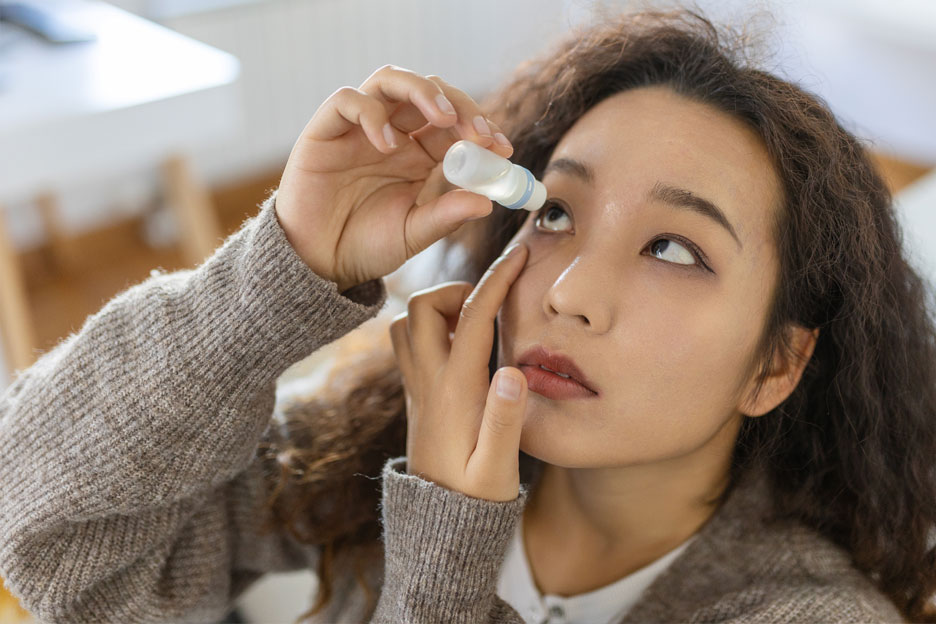Do you ever feel discomfort in your eyes or become excessively teary with no emotional reason? Dry eye syndrome could be the cause. Your eyes are precious organs that allow you to appreciate the beauty of our colourful world, so it is important to take good care of them.

Dry eyes: a common problem
You may be one of those people who are quick to shed tears, whether it’s because of a sad movie, heartfelt wedding vows, a sweet children’s recital or simply some good news. But lately, you’ve noticed that your eyes are showing signs of insufficient tear production: irritation, stinging, blinking, burning sensation or feeling like there’s something in your eye. You may be suffering from dry eye syndrome.
Dry eye syndrome, also known as keratitis sicca, is a rather common eye condition. It is said to affect between 5 and 30% of the population, with a higher proportion of women. At first, it can seem trivial, but when it causes discomfort, impedes on daily life or hinders vision, it is vital to seek a solution.
What causes dry eye syndrome?
To better understand what is happening to your eyes, it can be helpful and interesting to learn more about how they work. Tears are secreted by tear ducts and consist of several components: water, salt, oil, glucose and protein. They coat the eye as the eyelid blinks, forming a thin film that lubricates the eye, nourishes it, protects it from infections by clearing away foreign particles and hydrates the cornea.
Dry eye syndrome can develop in three cases:
- the eyes don't produce enough tears;
- the tears evaporate too quickly because they don't contain enough water;
- the proportions of the components change, causing an unbalance.
Several factors can be at play in these cases: hormonal changes, medication, environmental heat or dryness, age, the use of screens, etc.
What are the signs and symptoms of dry eye syndrome?
You may be suffering from keratitis sicca if you are experiencing some of the following symptoms:
- burning sensation or feeling like there’s something in your eye;
- itchiness;
- tearing;
- blurred vision;
- irritation/redness, for instance when exposed to wind or smoke;
- eye fatigue, especially at the end of the day or during activities requiring concentration (reading, working on a computer, knitting, etc.);
- sensitivity to light.
However, some of the listed symptoms can also be signs of a more severe affliction and may require immediate medical attention. Consult with your pharmacist or optometrist to orient you to the proper resource.
Prevention is key
Thankfully, it is possible to take measures that will protect your eyes from dryness. Here are some that you can follow on a daily basis:
- blink more often;
- wear glasses to protect your eyes from wind or sunlight;
- avoid exposing your eyes to air coming out of a blow dryer, air conditioner or fan;
- use a humidifier to combat dry air in winter;
- put your computer screen below eye level;
- follow the recommendations of your optician or optometrist on the use and care of your contact lenses;
- rest your eyes after 45 minutes of activity in front of a screen or book by closing them or blinking often to cover the eye with tear film.
Stopping smoking is also a good way to prevent the symptoms of dry eye syndrome. Another great reason to consult a health professional, such as your pharmacist, to quit cigarettes for good!
What are the treatments for dry eye syndrome?
If preventive measures are not enough and you are bothered by the symptoms of dry eye syndrome, there is a wide array of ophthalmic products available at the pharmacy that can help.
The type of medication that relieves keratitis sicca comes in topical form, i.e. applied directly in the eyes. There are various formulas: solutions, suspensions, gels, ointments. These products basically replace tears; they provide temporary relief of symptoms associated with keratitis sicca by “substituting” their lubricating qualities for the ones provided by tears, which the eyes are no longer producing in sufficient quantities.
Here are a few tips to ensure the safe and optimal use of ophthalmic products to alleviate dry eye syndrome:
- Use the product as needed, according to the manufacturer’s or your pharmacist’s instructions.
- Wash your hands thoroughly before using a product that must be applied to the eye.
- Ask your pharmacist to show you the proper administration technique for the product, taking its formulation into account (drop, gel or ointment).
- Throw away the container one month after using it for the first time. If you are using a one-time-use product, discard any unused product after its application.
- Don’t rub your eyes after applying the product.
- Keep your product to yourself; don’t share it with anyone else.
There are other treatments that are not described in this article, such as prescription medication and surgery. You should discuss the various options that are available to you with your eye-care professional.
Dry eye syndrome can be very troublesome, especially when it impedes on your daily activities. If your eyes are becoming an issue, the best thing to do is to consult an eye specialist, such as an optometrist. There is certainly no lack of choice in artificial tears, so your pharmacist can also be of help to select one. Don’t hesitate to ask her or him for assistance in choosing the best product for your needs. Every day, your eyes help you in countless ways; return the favour by taking the right steps to keep them healthy!
